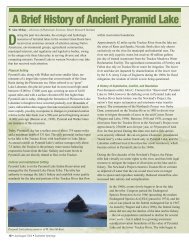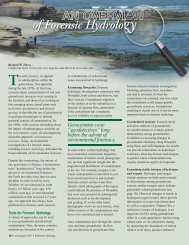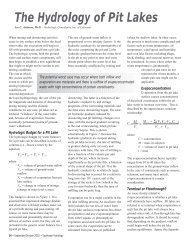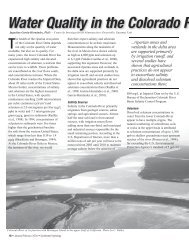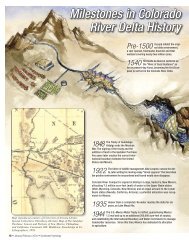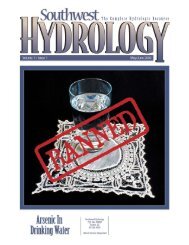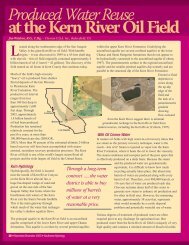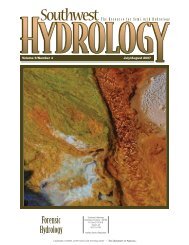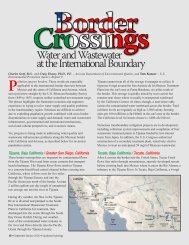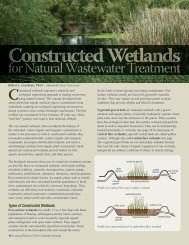Peruvian Mine Operation Using Dynamic System Modeling Charlie ...
Peruvian Mine Operation Using Dynamic System Modeling Charlie ...
Peruvian Mine Operation Using Dynamic System Modeling Charlie ...
You also want an ePaper? Increase the reach of your titles
YUMPU automatically turns print PDFs into web optimized ePapers that Google loves.
<strong>Peruvian</strong> <strong>Mine</strong> <strong>Operation</strong> <strong>Using</strong><br />
<strong>Dynamic</strong> <strong>System</strong> <strong>Modeling</strong><br />
<strong>Charlie</strong> Voss – Golder Associates and Henri Letient – Compañía <strong>Mine</strong>ra Antamina S.A.<br />
Located more than 4,300 meters<br />
(14,000 feet) above sea level in<br />
the <strong>Peruvian</strong> Andes, the Compañía<br />
<strong>Mine</strong>ra Antamina S.A. (Antamina) mine<br />
contains one of the largest copper-zinc<br />
ore bodies in the world. This worldclass<br />
mine required a water management<br />
planning tool to integrate water use and<br />
discharge requirements at the mine site.<br />
A dynamic system model (DSM) was<br />
developed to enable Antamina to quickly<br />
evaluate alternative mill production and<br />
water management strategies based on<br />
a set of water management objectives.<br />
The model allows the user to define<br />
initial conditions and a set of operating<br />
assumptions to project the performance<br />
of the mine system as a function of<br />
time. The major performance measures<br />
simulated by the model are the volume<br />
of water contained in the tailings facility<br />
and discharge to the local rivers.<br />
Water Management <strong>System</strong><br />
Annual precipitation at Antamina averages<br />
1,150 millimeters (around 45<br />
inches), but varies<br />
from as little as<br />
700 mm (28 inches) up to 1,700 mm<br />
(67 inches). Wet and dry seasons are<br />
pronounced, with less than 20 percent<br />
of precipitation occurring from May to<br />
September and over 50 percent falling<br />
December through March. The mean<br />
lake evaporation rate is 700 mm/yr.<br />
Water management objectives at<br />
Antamina are to ensure:<br />
• the tailings facility can accommodate<br />
a Probable Maximum Flood;<br />
• an adequate supply of water to operate<br />
the concentrator even during dry periods;<br />
• an acceptable riparian flow downstream<br />
of the tailings facility; and<br />
• sufficient fresh water for the<br />
camp and concentrator.<br />
Water must be managed from several<br />
major areas: a tailings impoundment,<br />
upstream diversion from four<br />
subbasins, three mine rock dumps, a<br />
low-grade ore stockpile, the concentrator<br />
site, and the open pit mine.<br />
The mine site contains a 570-millionmetric-ton<br />
tailings facility (see<br />
photo) consisting of a large rock-fill dam<br />
that will ultimately reach a height of<br />
250 meters (820 feet). Tailings from the<br />
milling operation are pumped in a slurry<br />
into the facility; the rate of production<br />
defines the dam-raising schedule. The<br />
facility must maintain sufficient capacity<br />
to contain both the tailings solids and<br />
water in the facility plus the volume<br />
of water that would be produced by<br />
a Probable Maximum Flood. Under<br />
normal conditions, the majority of the<br />
water is recycled back to the mill for<br />
processing, so the dam-raising schedule<br />
is largely determined by the rate new<br />
tailings are deposited. However, during<br />
an extended period of precipitation with<br />
high runoff and precipitation volumes,<br />
it may be necessary to discharge some<br />
water from the tailings pond to maintain<br />
the minimum storage requirement.<br />
Runoff from the four subbasins above<br />
the tailings facility is diverted around<br />
the facility and stored in several<br />
impoundments where it supplies fresh<br />
water for the mine. The reservoirs<br />
are connected by a series of drainage<br />
channels and pipelines<br />
The tailings facility at the Antamina mine contains<br />
a slurry of tailings retained by a rock-fill dam.<br />
22 • July/August 2006 • Southwest Hydrology
that allow flows to be directed<br />
as needed, such as dry-season<br />
releases to meet downstream<br />
riparian flow requirements.<br />
<strong>Dynamic</strong> <strong>System</strong> Model<br />
The DSM was developed by<br />
Golder Associates by first<br />
breaking down the water<br />
management system into<br />
subsystems, then partitioning<br />
the subsystems into components<br />
until all the processes and<br />
conditions were identified.<br />
This approach helped identify<br />
the interactions among the<br />
components and between<br />
the components and the<br />
environment. A conceptual model<br />
of the system and subsystems was<br />
documented and described graphically in<br />
a flow diagram. A mathematical model<br />
was then developed and calibrated.<br />
The DSM must account for all<br />
precipitation that falls on the mine,<br />
including that which passes through the<br />
facility as runoff or is diverted around<br />
it, is retained in the tailings, recycled<br />
within the mill, discharged in the slurry,<br />
or seeps through the tailings dam, as<br />
well as evaporation and transpiration.<br />
Stage curves were developed for each<br />
of the reservoirs and integrated in the<br />
model. Periodic bathometric surveys<br />
of the tailings facility provide updated<br />
storage curve data so the model can<br />
account for tailings placed in the facility.<br />
Example dashboard for defining simulation scenarios.<br />
example above), which contain intuitive<br />
input fields and controls so that users<br />
can easily define initial conditions (such<br />
as water levels, tailings volume, season)<br />
and an operational scenario (ore type,<br />
mill production rate). Users can select<br />
a randomly generated climate based<br />
on local statistics or specify extreme<br />
conditions. The interface<br />
also provides easy access<br />
to model projections.<br />
Use at the <strong>Mine</strong><br />
The DSM is being used<br />
for day-to-day operations<br />
and long-range planning<br />
at the mine. For the latter,<br />
it simulates the behavior<br />
of the water management<br />
system under different<br />
climate conditions and<br />
operational rules. Typical<br />
climate conditions that<br />
are considered include<br />
historical precipitation and<br />
evaporation conditions<br />
(previous five years),<br />
and 100-year wet and dry conditions.<br />
Alternative water management<br />
approaches being investigated include:<br />
• zero discharge from the tailings<br />
facility other than water used<br />
in the concentrator;<br />
see Antamina, page 31<br />
<br />
<br />
<br />
<br />
Capacities of the diversion channels,<br />
pipelines, and gate valves are also<br />
represented in the model. Decision rules<br />
based on existing Antamina procedures<br />
for operating the system to achieve<br />
the water management objectives<br />
were incorporated in the model.<br />
A preliminary version of the model was<br />
developed in Microsoft Excel for use<br />
during the design and construction phase<br />
of the mine, then converted to a true<br />
dynamic system model using the GoldSim<br />
software platform. To simplify its use by<br />
site personnel, a customized user interface<br />
offers a series of “dashboards” (see<br />
<br />
<br />
<br />
<br />
<br />
<br />
<br />
<br />
<br />
<br />
<br />
<br />
<br />
July/August 2006 • Southwest Hydrology • 23
Utility Planning, continued from page 19<br />
future costs of various mixes of supply<br />
enhancement, water reuse, and demand<br />
management actions. For Philadelphia,<br />
the DSS assessed how various wateruse<br />
and wastewater-return scenarios<br />
interacted with natural hydrology<br />
patterns in a watershed of high aesthetic<br />
value. By collaborating with the test site<br />
utilities, the research team was able to<br />
demonstrate the utility of the WEAP DSS<br />
for long-term, sustainable water-supply<br />
planning. Planning issues addressed that<br />
are commonly faced by utilities include:<br />
• the timing of investments in<br />
future facility expansions;<br />
• investments in demand management<br />
and water reuse and recycling;<br />
• coordinated operation of<br />
multiple supply sources;<br />
• changing environmental regulations;<br />
• service-area expansion and<br />
regional coordination; and<br />
• water supply and wastewater<br />
treatment management to improve<br />
the status of receiving water bodies.<br />
While this list does not cover every<br />
planning issue that utilities face,<br />
the research demonstrated that an<br />
integrated DSS framework could<br />
address and analyze future scenarios<br />
comprised of multiple elements.<br />
Getting the Most From a DSS<br />
As with any new software tool, there is<br />
a learning curve before the application<br />
can be completely mastered. This goes<br />
beyond manipulating the interface and<br />
extends to issues of gathering the correct<br />
data, formulating the proper questions,<br />
and interpreting the output. These are<br />
ubiquitous challenges for applying any<br />
DSS; our experience at the test sites<br />
showed that the integrated, flexible, and<br />
transparent nature of a WEAP DSS allows<br />
analysts to address these challenges<br />
more directly. The biggest challenge is<br />
not figuring out how to make a WEAP<br />
DSS represent particular scenarios,<br />
but defining which scenarios are most<br />
appropriate, useful, and compelling.<br />
Developing WEAP DSS in the three cities<br />
provided important insights about the way<br />
that analysis supports decision-making<br />
by water utilities. Often, each discipline<br />
working within a utility maintains an<br />
independent set of analytical tools; attempts<br />
to integrate these tools often founder on<br />
resistance to make the simplifications<br />
needed to achieve integration. Typically<br />
each analyst, an expert in his or her own<br />
discipline, feels that simplifying their<br />
analysis in the interest of developing an<br />
integrated DSS should be avoided so as<br />
not to lose important insights. From the<br />
perspective of utility strategic planners,<br />
however, integrating the various factors<br />
that can influence long-term water<br />
planning into scenarios developed in a<br />
graphical environment is essential for<br />
the evaluation of various tradeoffs.<br />
One potentially fruitful area of research for<br />
a utility is to assess whether simplifications<br />
pursued in favor of integrated analysis<br />
would change the decision that would<br />
be made based on the output of a DSS.<br />
This research assumes, however, that a<br />
software package is available that can<br />
be configured to represent both stylized<br />
schematics and detailed representations<br />
of a water utility. WEAP is such a<br />
system. Through continued use of<br />
WEAP DSS, we can iteratively learn to<br />
derive the maximum benefit from it.<br />
AwwaRF supported this research by NHI and SEI.<br />
More information is available at www.weap21.org.<br />
Contact David Purkey at dpurkey@n-h-i.org.<br />
Reference<br />
Huber-Lee, A., C. Swartz, J. Sieber, J. Goldstein, D.<br />
Purkey, C. Young, E. Soderstrom, J. Henderson,<br />
and R. Raucher, 2006. Decision support<br />
systems for sustainable water supply planning.<br />
Awwa Research Foundation. Denver, CO.<br />
Antamina, continued from page 23<br />
• 100-liter-per-second withdrawal from<br />
the tailings facility to a polishing pond,<br />
where the water commingles with runoff<br />
and eventually is released to the river;<br />
• maintaining minimum river flow<br />
requirements by releasing fresh<br />
water from the polishing pond<br />
versus from the main reservoir.<br />
Other inputs in the simulations include<br />
the rate that ore is processed in the mill,<br />
the types of ore being processed, and<br />
the schedule for increasing the dam<br />
crest. The simulations track whether the<br />
ore processing rate can be maintained<br />
under different climate conditions<br />
and operational assumptions. Under<br />
the extreme-wet climate condition<br />
assumption, the likelihood of production<br />
being impacted due to unacceptable<br />
water elevations behind the dam can<br />
be assessed. Alternatively, the extremedry<br />
scenario evaluates whether the<br />
concentrator throughput would have to be<br />
periodically reduced or suspended because<br />
of insufficient water availability in the<br />
tailings facility. The ability of the mine to<br />
maintain minimum flow requirements in<br />
the river by releasing water from the fresh<br />
water reservoirs can also be assessed.<br />
The DSM has provided insights into the<br />
appropriateness of some operational rules<br />
and a diagnostic understanding of the<br />
water management system. It highlights,<br />
for example, the need to regularly evaluate<br />
existing conditions at the mine to assess<br />
possible water deficits during the dry<br />
season and whether emergency measures<br />
should be instituted. The model is also<br />
being used for planning the dam-raising<br />
schedule to reduce the likelihood that<br />
the freeboard criteria will be violated.<br />
The greatest challenge in developing the<br />
model was creating an accurate conceptual<br />
model of the water management system<br />
and decision rules and assembling<br />
and verifying the requisite input data.<br />
Considerable time was also required<br />
to communicate information about the<br />
capabilities of the simulation model and<br />
engage clients at the mine who were not<br />
directly involved in its development.<br />
Because mine conditions are constantly<br />
changing, periodic updates to the<br />
conceptual model are required to ensure<br />
consistency with actual conditions.<br />
Contact <strong>Charlie</strong> Voss at cvoss@golder.com.<br />
July/August 2006 • Southwest Hydrology • 31



